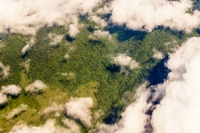
17 June is the World Day to Combat Desertification and Drought
Desertification negatively affects the soil and ecosystems, with dire impacts on people due to the increased risk of food insecurity.
Desertification negatively affects the soil and ecosystems, with dire impacts on people due to the increased risk of food insecurity.
Thanks to satellite data systems NASA has been monitoring 1,000 hectares of land across Canada and Alaska. The tundra has already changed because of global warming.
World Environment Day was established in 1972 during the United Nations Conference on the Human Environment, which led to the creation of the United Nations Environment Programme (UNEP). Its aim is “encouraging worldwide awareness and action for the protection of our environment”. Since its inception, WED has developed into a global platform for raising awareness and taking action,
Lo sbiancamento avrebbe ucciso il 35 per cento dei coralli che compongono il sito australiano classificato Patrimonio mondiale dell’Umanità.
Winner of the Goldman Environmental Prize, Luis Jorge Rivera Herrera tells LifeGate about his battle to protect endangered leatherback turtles and the Puerto Rican coastline.
A Canadian study shows that if the world consumes all its reserves of oil, gas and coal, average temperatures would skyrocket.
Sea is the cradle of life, but Chilean waters have turned into a grave. Unprecedented red tide is killing millions of marine creatures in the Pacific Ocean, off the coast of Chiloé Island, in Los Lagos region, southern Chile. It is the largest die-off of marine wildlife in the country’s history. What caused the red
A report has sounded the alarm about the dangers of global warming for the citizens of the United States. The report, The impacts of climate change on human health in the United States, was released by the country’s government in 2016. Climate change is causing a surge in mental and respiratory illnesses, allergies, deaths from
There’s no good news and figures are appalling. The warning comes from scientists, not environmentalists. After the records set in the first quarter of 2016, April was 1.1 degrees warmer than the April average temperatures. It’s a figure too close to the 1.5-degree limit set in the Paris Agreement that signing countries should abide by.
The connection between digital technology and satellite imagery is revolutionising the way natural resources can be used, including monitoring deforestation and desertification. As countries strive to reduce their carbon footprint by limiting deforestation, it is important they have the right tools. These must be transparent, consistent over time and suitable. To help these countries, the Food








